Powered by Coverage.com (NPN: 19966249)
Coverage.com, LLC is a licensed insurance producer (NPN: 19966249). Coverage.com services are only available in states where it is licensed. Coverage.com may not offer insurance coverage in all states or scenarios. All insurance products are governed by the terms in the applicable insurance policy, and all related decisions (such as approval for coverage, premiums, commissions and fees) and policy obligations are the sole responsibility of the underwriting insurer. The information on this site does not modify any insurance policy terms in any way.
Best car insurance in North Carolina for 2026

Powered by Coverage.com (NPN: 19966249)
Coverage.com, LLC is a licensed insurance producer (NPN: 19966249). Coverage.com services are only available in states where it is licensed. Coverage.com may not offer insurance coverage in all states or scenarios. All insurance products are governed by the terms in the applicable insurance policy, and all related decisions (such as approval for coverage, premiums, commissions and fees) and policy obligations are the sole responsibility of the underwriting insurer. The information on this site does not modify any insurance policy terms in any way.
Best car insurance companies in North Carolina
Car insurance in North Carolina costs an average of $153 per month for full coverage and $48 per month for minimum coverage, according to data from Quadrant Information Services. While price is important, it isn't everything. Bankrate hand-selected the best car insurance companies in North Carolina that balance budget, financial strength and strong customer service.

Bankrate Score
Avg. monthly premium
Full coverage
Avg. monthly premium
Min. coverage
Why Geico made our list: Drivers with a tight budget may want to consider Geico, as it offers a long list of potential discounts and low average rates. Some of its savings opportunities include discounts for military members and employees who work for select companies and organizations.
| Bankrate Score | 4.3 |
| J.D. Power | 670/1,000 |
| AM Best Rating | A++ |
Geico standout features
- DriveEasy telematics program
- Available nationwide
- Robust digital tools

Bankrate Score
Avg. monthly premium
Full coverage
Avg. monthly premium
Min. coverage
Why State Farm made our list: Currently, 159 cities in North Carolina have a State Farm office, so drivers can take advantage of its exclusive local agents across the region. If you prefer a digital approach, the company’s highly rated mobile tools give you easy access to manage your policy, file claims, make payments and even call for roadside assistance.
| Bankrate Score | 4.3 |
| J.D. Power | 646/1,000 |
| AM Best Rating | A++ |
State Farm standout features
- Highly-rated mobile app
- Telematics program available
- Wide network of local agents

Bankrate Score
Avg. monthly premium
Full coverage
Not available
Avg. monthly premium
Min. coverage
Not available
Why USAA made our list: If you're eligible for a USAA policy, you may want to consider getting a quote. Not only does it offer some of the lowest average rates, but USAA's customer service is considered some of the best in the industry.
| Bankrate Score | 4.3 |
| J.D. Power | 749/1,000 |
| AM Best Rating | A++ |
USAA standout features
- Tied for Best Car Insurance Company Bankrate Award
- Tailored coverage options for military community
-
Only available to military and their family

Bankrate Score
Avg. monthly premium
Full coverage
Avg. monthly premium
Min. coverage
Why Nationwide made our list: Nationwide might be a good fit if you want one company that can handle all your financial business. It offers plenty of other insurance lines and financial products, and it advertises average savings of $1,032 per year if you bundle home and auto.
| Bankrate Score | 4 |
| J.D. Power | 691/1,000 |
| AM Best Rating | A+ |
Nationwide standout features
- Pay-per-mile coverage available
- Two telematics programs
- Long list of discounts

Bankrate Score
Avg. monthly premium
Full coverage
Avg. monthly premium
Min. coverage
Why Erie made our list: Erie is a regional insurance company, operating in 12 states (including North Carolina). Erie not only took the top spot in the southeast region of J.D. Power's Auto Insurance Study, but it was also named the highest rated auto insurance provider by Consumer Reports.
| Bankrate Score | 4.1 |
| J.D. Power | 718/1,000 |
| AM Best Rating | A+ |
NYCM standout features
- Rate lock could help keep premiums low
- YourTurn telematics rewards safe driving
- Full coverage policies include pet injury coverage
The Bankrate Promise
Read our full methodologyAt Bankrate, we strive to help you make smarter financial decisions. While we adhere to strict , this post may contain references to products from our partners. Here's an explanation of . Our content is backed by Coverage.com LLC, a licensed entity (NPN: 19966249). For more information, please see our
78
years of industry experience
10
licensed staff
34.5K
ZIP codes examined
120
carriers reviewed
Powered by Coverage.com (NPN: 19966249)
Coverage.com, LLC is a licensed insurance producer (NPN: 19966249). Coverage.com services are only available in states where it is licensed. Coverage.com may not offer insurance coverage in all states or scenarios. All insurance products are governed by the terms in the applicable insurance policy, and all related decisions (such as approval for coverage, premiums, commissions and fees) and policy obligations are the sole responsibility of the underwriting insurer. The information on this site does not modify any insurance policy terms in any way.

Compare auto insurance rates
Powered by Coverage.com (NPN: 19966249)
Coverage.com, LLC is a licensed insurance producer (NPN: 19966249). Coverage.com services are only available in states where it is licensed. Coverage.com may not offer insurance coverage in all states or scenarios. All insurance products are governed by the terms in the applicable insurance policy, and all related decisions (such as approval for coverage, premiums, commissions and fees) and policy obligations are the sole responsibility of the underwriting insurer. The information on this site does not modify any insurance policy terms in any way.
How to find the best car insurance in North Carolina
Not all car insurance companies are the same. These tips can help you find the best one for you:
Learn more about North Carolina car insurance:
Frequently asked questions
Methodology
Bankrate utilizes Quadrant Information Services to analyze November 2025 rates for all ZIP codes and carriers in all 50 states and Washington, D.C. Rates are weighted based on the population density in each geographic region. Quoted rates for our base profile are based on the following characteristics and full coverage limits with bundling and paperless billing discounts applied:

Bodily injury liability
$100,000 per person$300,000 per accident
Property damage liability
$50,000 per accidentPersonal injury protection
$100,000 per accidentUninsured motorist bodily injury
$100,000 per person$300,000 per accident
Collision deductible
$500Comprehensive deductible
$500To determine minimum coverage limits, Bankrate used minimum coverage that meets each state’s requirements. These are sample rates and should only be used for comparative purposes. Your quotes will differ.
If otherwise specified, the base profile has been modified with the following driver characteristics:
Other profiles
Bankrate Score
Our 2025 Bankrate Score for auto insurance considers key variables that our insurance editorial team determined impact policyholders’ experiences with an insurance company. These factors include a robust assessment of each company’s cost of coverage, product availability, financial strength ratings, online capabilities and customer and claims support accessibility. We grouped these factors into three essential categories — cost and ratings, coverage and savings, and support — which we then weighted in a tiered approach.
Each category was assigned a metric to determine performance, and the weighted sum adds up to a company’s total Bankrate Score — out of 5 points. Our scoring model provides a comprehensive view, indicating when companies excel across several key areas and highlighting where they fall short.
- Tier 1 (Cost & ratings): To determine how well auto insurance companies satisfy these priorities, our team analyzed quoted premiums from Quadrant Information Services (if available), as well as any of the latest third-party agency ratings from J.D. Power, AM Best, Demotech and the National Association of Insurance Commissioners (NAIC).
- Tier 2 (Coverage & savings): We assessed companies’ coverage options and availability to help policyholders find a provider that balances cost with coverage. Additionally, we evaluated the discount options listed on each company’s website.
- Tier 3 (Support): To encompass the many ways an auto insurance company can support policyholders, we analyzed avenues of customer accessibility along with community support. This analysis incorporated additional financial strength ratings from S&P and Moody’s and factored in a company’s corporate sustainability efforts.
Tier scores are unweighted to show the company's true score in each category out of a possible five points.



